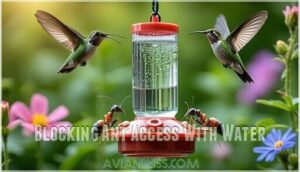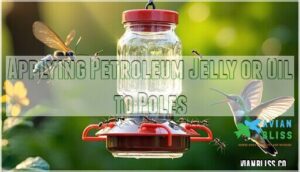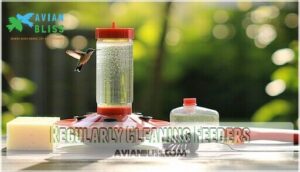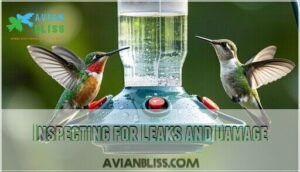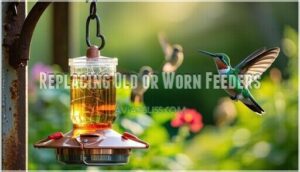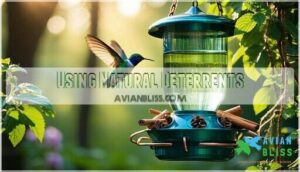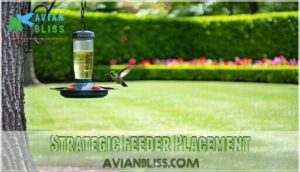This site is supported by our readers. We may earn a commission, at no cost to you, if you purchase through links.
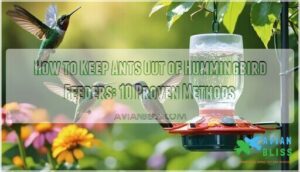
Install ant moats filled with water around feeder poles – these create an impassable barrier since ants can’t swim.
Apply petroleum jelly or cooking oil to feeder poles for a slippery defense that sends ants sliding back down.
Position feeders away from trees and ant trails, using fishing line instead of chains for hanging.
Clean spills immediately and check for leaks regularly, as even tiny drops attract these persistent insects.
Think of it as building a fortress around your nectar – multiple barriers work better than relying on just one defense strategy.
Table Of Contents
- Key Takeaways
- Preventing Ant Infestations
- Keeping Ants Out Feeders
- Maintaining Feeders
- Using Natural Deterrents
- Strategic Feeder Placement
- Frequently Asked Questions (FAQs)
- How do I keep ants out of my hummingbird feeder?
- Why do you put aluminum foil on hummingbird feeders?
- How to make a hummingbird feeder ant proof?
- What will stop ants from climbing a pole?
- How do you keep ants out of a hummingbird feeder?
- How to deter bees from hummingbird feeders?
- Do hummingbird feeders have ant moats?
- How to clean a hummingbird feeder?
- What keeps ants away from hummingbird feeders?
- How to stop ants from climbing up a pole?
- Conclusion
Key Takeaways
- Create physical barriers – You’ll need to install water-filled ant moats around feeder poles and apply petroleum jelly or cooking oil to create slippery surfaces that ants can’t cross.
- Use smart hanging techniques – Hang your feeders with fishing line instead of chains or rope, since ants can’t grip the slippery surface to climb up and reach the nectar.
- Place feeders strategically – Position your feeders at least six feet away from trees and ant trails, choosing shaded spots that don’t have direct ground contact to cut off ant highways.
- Maintain your feeders regularly – Clean spills immediately, check for leaks weekly, and replace worn feeders before they become ant magnets that’ll attract entire colonies to your backyard.
Preventing Ant Infestations
You can stop ants from reaching your hummingbird feeders by creating barriers they can’t cross, like water-filled moats or slippery fishing line.
Build an ant-proof fortress around your feeder using water moats and slippery barriers that turn tiny invaders into frustrated swimmers.
Think of it as building a tiny fortress around your feeder – ants are persistent little creatures, but they’re not great swimmers or tightrope walkers, which makes them unable to cross certain barriers.
Using Ant Moats and Guards
Ant moats work like tiny swimming pools that stop crawling invaders cold.
Fill the built-in water reservoir or add a separate stainless moat for maximum effectiveness.
When moats fail, ant guards containing bird-safe Permethrin offer foolproof protection.
You can craft DIY guards using bottle caps and wire.
These ant deterrent solutions create an ant proof hummingbird feeder without harming birds.
Many people buy pre-made ant barriers for convenience.
Creating Physical Barriers
Physical barriers work like fortress walls against ant invasions.
Water barriers create impassable moats around feeders, while DIY ant moats using bottle caps cost pennies.
Petroleum jelly on poles stops climbers, but avoid Vaseline near birds—it’s dangerous.
Smart feeder placement over water sources doubles protection.
An ant guard provides backup when other barriers fail, ensuring your hummingbirds feast undisturbed.
Physical barriers and creative deterrents can be an effective combination.
DIY solutions, such as petroleum jelly, can be cost-effective and efficient.
Hanging Feeders With Fishing Line
Here’s a simple trick that works like magic: hang your feeder with fishing line instead of chain or rope.
Fishing line creates an invisible fortress – ants can’t grip the slippery surface to reach your feeder.
Ants can’t grip the slippery surface, making this an effective hanging feeder ant solution. Choose 20-pound test line for ideal line thickness and knot strength.
Clear line maintains line visibility while ensuring feeder stability and bird safety for your ant proof hummingbird feeder setup.
Another effective solution is to install an ant moat above the feeder.
Keeping Ants Out Feeders
Once ants discover your hummingbird feeder, they’ll march straight to it like tiny soldiers heading to their favorite restaurant.
You can stop these uninvited guests by using water barriers, natural repellents, and slippery substances that make climbing impossible for determined ants.
Blocking Ant Access With Water
Water barriers create an impenetrable fortress around your feeder.
Ant moats work like medieval castle defenses—ants can’t swim across.
Here’s your water-blocking arsenal:
- Fill built-in moats with fresh water weekly
- Install stainless moats for durability and easy cleaning
- Create DIY moats using bottle caps and wire hooks
- Monitor moat evaporation to maintain ant-proof protection
Using Natural Repellents Like Mint and Cinnamon
When ants discover your feeder’s sweet treasure, natural repellents offer a gentle solution.
Sprinkle cinnamon around the base to create effective barriers that ants won’t cross. Fresh mint leaves rubbed on poles work as powerful deterrents. These natural ant repellent options protect hummingbirds while keeping pests away.
Using ant moats filled with water is another effective way to prevent ants from reaching the feeder. Reapplication frequency depends on weather conditions.
| Method | Application | Effectiveness |
|---|---|---|
| Cinnamon Barriers | Sprinkle ground cinnamon around feeder base | High – strong scent deters ants |
| Mint Application | Rub fresh leaves on poles and nearby surfaces | Medium – needs frequent replacement |
| Essential Oil Alternatives | Apply peppermint oil to surrounding areas | High – concentrated scent lasts longer |
| DIY Sprays | Mix water with mint or cinnamon extracts | Medium – requires regular reapplication |
| Combined Approach | Use multiple natural deterrents together | Very High – creates layered protection |
Applying Petroleum Jelly or Oil to Poles
Creating slippery barriers stops determined climbers in their tracks.
Apply petroleum jelly or cooking oil to feeder poles, but keep it away from where hummingbirds perch to prevent bird feather contamination.
To further deter ants, consider using built-in ant moats on your feeders.
Here’s your oil application safety checklist:
- Target pole sections below feeding ports only
- Reapply weekly or after rain washes barriers away
- Choose food-grade oils for environmental concerns
Maintaining Feeders
You can’t win the ant war if your feeder’s falling apart, leaking nectar like a broken faucet.
Regular maintenance keeps your hummingbird diner clean and ant-proof, just like washing dishes prevents unwanted kitchen guests.
Regularly Cleaning Feeders
Every few days, you’ll need to tackle your hummingbird feeder maintenance routine.
Think of it as preventive medicine for your backyard birds.
Sugar residue acts like ant bait, so thorough cleaning prevents nectar spoilage and mold prevention.
Feeder disassembly allows complete residue removal from all crevices.
| Cleaning Frequency | Weather Condition | Action Required |
|---|---|---|
| Daily | Hot (85°F+) | Full disassembly wash |
| Every 3 days | Moderate temps | Quick rinse cycle |
| Weekly | Cool weather | Deep cleaning routine |
Inspecting for Leaks and Damage
Check your feeder like a detective hunting for clues. Look for feeder material degradation around seams and joints where weather-related damage creates weak spots.
Watch for leakage indicators like sticky residue or sugar crystals below ports. Even tiny cracks need attention—they’re ant highways waiting to happen.
Hot weather expands nectar, making small problems worse for hummingbird feeder maintenance.
Replacing Old or Worn Feeders
Sometimes your trusty hummingbird feeder becomes more hole than helper. Material degradation happens faster than you’d think, especially with cheap plastic models. When leak prevention fails repeatedly, it’s time for an upgrade.
Consider a hummingbird feeder replacement to extend the life of your feeder setup. Here’s your cost analysis for feeder lifespan decisions:
- Glass feeders last 5-10 years vs. plastic’s 1-2 years
- Antproof feeders with built-in moats save money long-term
- Stainless steel components resist wear and cracking
- Upgrade options include ant guards and better sealing systems
- Quality hummingbird feeder maintenance starts with smart purchasing
Using Natural Deterrents
You can turn your garden into an ant-free zone using natural deterrents that won’t harm hummingbirds or other wildlife.
These eco-friendly methods rely on plants, essential oils, and homemade sprays that ants naturally avoid, giving you peace of mind while keeping your feeders accessible to hungry hummers.
Planting Ant-Repellent Plants Like Mint and Basil
Mint plants and basil varieties create powerful natural ant repellent zones around your hummingbird feeders.
These aromatic herbs produce oils that ants despise, making them excellent companion planting choices.
Plant spearmint or peppermint in containers near feeders for controlled garden placement. Basil variety selection matters—sweet basil works best.
Both herbs offer natural remedies without harming birds. Regularly cleaning feeders is also important, as even small drips can attract unwanted pests.
Using Essential Oils Like Peppermint and Lemongrass
Essential oils pack a powerful punch against ants while keeping your hummingbird feeder ant prevention efforts natural.
Peppermint oil works best at 10-15% oil concentration mixed with water.
Apply this natural ant repellent to poles and ground areas, never directly on feeders for bird safety.
Combine lemongrass and clove oils for stronger results.
Reapply weekly or after rain for consistent ant deterrent hummingbird feeder protection.
Creating a Natural Ant Repellent Spray
Making your own natural ant repellent spray puts you in control of ingredients while saving money.
These DIY spray recipes combine common household items into powerful ant deterrents. Vinegar-based solutions and essential oil blends work exceptionally well around hummingbird feeders.
Popular homemade solutions include:
- Lemon juice spray – Mix 1 part lemon juice with 3 parts water for contact elimination
- Vinegar and tea tree blend – Combines strong odors that mask ant pheromone trails
- Sugar and borax solution – Creates effective ant traps when applied to trails
Strategic Feeder Placement
Where you place your hummingbird feeder can make or break your ant-fighting efforts, so choose your spot like you’re picking real estate.
You’ll want to hang feeders away from trees and ant highways, mount them without ground contact, and avoid areas where ant colonies throw their backyard barbecues, which is crucial for ant-fighting efforts.
Choosing Shady Spots Away From Trees
Smart feeder location acts as your first line of defense against unwanted ant visitors.
Position your hummingbird feeders in shaded areas at least six feet from tree trunks and branches. This strategic placement reduces ant highways while preserving nectar quality through reduced evaporation and avoiding overheating that attracts more insects.
To further enhance safety, consider predator prevention measures.
| Shade Benefits | Tree Distance Benefits |
|---|---|
| Reduced evaporation keeps nectar fresh longer | Eliminates ant highways from branches |
| Prevents overheating that attracts ants | Blocks easy climbing routes to feeders |
| Preserves nectar quality in hot weather | Reduces visibility concerns for maintenance |
| Maintains ideal feeding temperatures | Prevents branch-dropping access points |
| Minimizes sunlight exposure damage | Forces ants to cross open ground barriers |
Avoiding Areas Near Ant Colonies
When scouting for your hummingbird feeder, avoid ant colony proximity like you’d avoid a hornet’s nest.
Watch for ant trails leading to potential nest sites during a brief observation period. If you spot heavy ant traffic, consider alternative locations at least ten feet away.
Moving your feeder beats constantly battling established ant highways to your nectar station, and it is a more effective way to manage the situation by choosing a location that is not prone to heavy ant traffic.
Mounting Feeders Without Direct Ground Contact
Once you’ve scouted ant-free zones, elevate your feeders to cut off ground access entirely.
Feeder pole selection matters—choose smooth metal over textured surfaces that give ants grip.
Window mounted feeders work brilliantly since ants can’t bridge the gap.
For balcony feeder placement, use hanging wire alternatives or elevated platforms.
This ant barrier for feeders stops climbing before it starts, creating an effective barrier.
Frequently Asked Questions (FAQs)
How do I keep ants out of my hummingbird feeder?
Ants marching toward your feeder? You’ll need an ant moat filled with water to create an uncrossable barrier.
Hang feeders with fishing line, apply cinnamon around the base, or use natural peppermint oil deterrents.
Why do you put aluminum foil on hummingbird feeders?
You’ll wrap aluminum foil around feeder poles to create a slippery barrier that ants can’t climb.
It’s like giving ants ice skates – they simply slide right off before reaching your nectar.
How to make a hummingbird feeder ant proof?
Sarah watched helplessly as ants formed highways to her feeder.
You’ll create an ant-proof fortress by installing water-filled moats, hanging feeders with slippery fishing line, and applying natural repellents like cinnamon around the base.
What will stop ants from climbing a pole?
Apply petroleum jelly or cooking oil around the pole’s base to create a slippery barrier ants can’t cross.
You can also wrap duct tape sticky-side-out or use commercial ant guards for effective protection.
How do you keep ants out of a hummingbird feeder?
Like medieval castle defenders, you’ll need water-filled ant moats around your feeder’s base.
Use fishing line for hanging since ants can’t grip it.
Clean regularly and try cinnamon sprinkles—those tiny invaders hate the spice!
How to deter bees from hummingbird feeders?
Choose feeders with bee guards or small feeding ports.
Place feeders in shaded areas since bees prefer sunny spots.
Clean up spilled nectar immediately, and consider yellow-free feeders—bees aren’t attracted to red like hummingbirds are.
Do hummingbird feeders have ant moats?
Coincidentally, most modern hummingbird feeders come equipped with built-in ant moats.
You’ll simply need to fill these small water reservoirs regularly.
If yours doesn’t have one, you can purchase separate moats or create DIY versions easily.
How to clean a hummingbird feeder?
Clean your hummingbird feeder every few days using mild soap and warm water.
Scrub thoroughly, rinse completely, and let it dry before refilling.
Hot weather requires daily cleaning to prevent mold and spoilage.
What keeps ants away from hummingbird feeders?
Water-filled ant moats act as tiny fortresses around your feeder’s base.
You can also hang feeders with fishing line, apply cinnamon around poles, or use peppermint oil as natural deterrents that won’t harm birds.
How to stop ants from climbing up a pole?
Apply petroleum jelly or cooking oil around the pole’s base to create a slippery barrier.
You can also wrap duct tape sticky-side out or sprinkle cinnamon powder around the pole’s foundation to deter climbing ants effectively.
Conclusion
Testing reveals that combining multiple barriers creates an impenetrable defense system against ant invasions.
When you implement ant moats, petroleum jelly barriers, and strategic placement together, you’ll transform your feeding station into a fortress that keeps these persistent insects at bay.
Remember, learning how to keep ants out of hummingbird feeders isn’t just about one trick—it’s about layering defenses.
Clean regularly, inspect for leaks, and maintain your barriers.
Your hummingbirds will thank you with frequent visits.
- https://www.thespruce.com/how-to-keep-ants-out-of-hummingbird-feeder-8665382
- https://www.familyhandyman.com/article/keep-ants-out-hummingbird-feeders/
- https://www.marthastewart.com/how-to-keep-ants-out-of-hummingbird-feeder-11739101
- https://www.pinterest.com/search/pins/?q=diy%20ant%20moat%20for%20hummingbird%20feeder&rs=rs&eq=&etslf=3581&term_meta[]=diy%20ant%20moat%20for%20hummingbird%20feeder%7Crecentsearch%7C0
- https://goto.walmart.com/c/1943169/565706/9383?subId1=homesandgardens-us-1182957024425586639&sharedId=homesandgardens-us&u=https%3A%2F%2Fwww.walmart.com%2Fip%2FMcCormick-Kosher-Ground-Cinnamon-2-37-oz-Bottle%2F10535029

